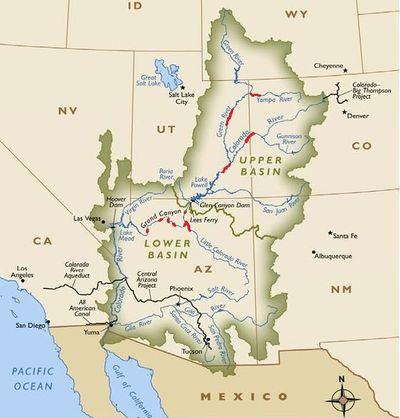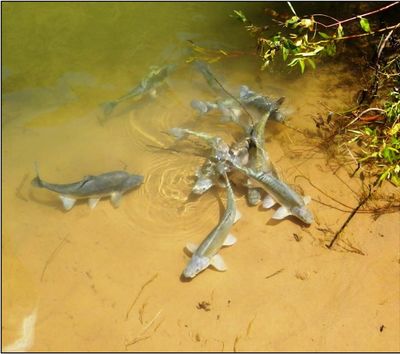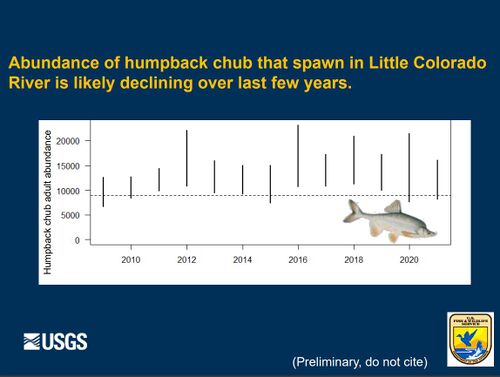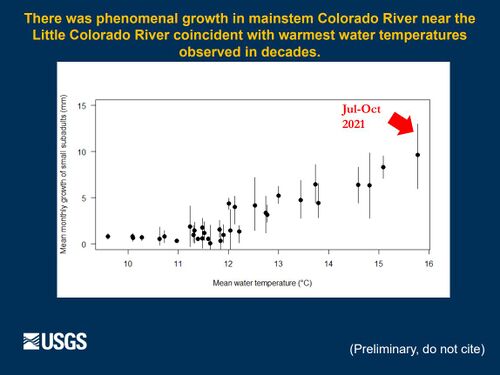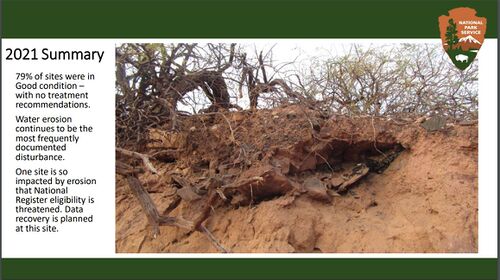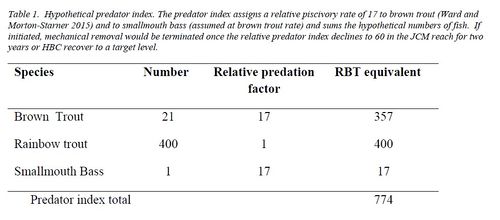|
Things are looking up for a rare Colorado River fish, the endangered humpback chub. The U.S. Fish and Wildlife Service (Service) recently completed a species status assessment (SSA) and a 5-year status review that concluded the current risk of extinction is low, such that the species is not in danger of extinction throughout all of its range. The SSA explained that the largest population of humpback chub, which is found in the Colorado and Little Colorado rivers in the Grand Canyon of Arizona, is a stable population of about 12,000 adults.
Our SSA also explained that four smaller populations in the Green and Colorado rivers of the upper Colorado River basin have persisted and do not appear to be in immediate danger of extinction. All five populations are wild, persisting without the need for hatchery stocking. These population-monitoring results, when coupled with ongoing flow management and nonnative predatory fish control, mean that the humpback chub will be considered for reclassification from endangered to threatened in the next year.
Although this unique fish is making a big step toward recovery it still needs help. Conservation work by a diverse group of stakeholders has been one of the key contributions in recovering this native fish. State, tribal, federal, and private stakeholders collaborate via the Upper Colorado River Endangered Fish Recovery Program (established in 1988) and the Glen Canyon Dam Adaptive Management Program (established in 1997) to continue the monitoring programs and to reduce threats to this species’ recovery. “Endangered species recovery in altered and heavily managed ecosystems like the Colorado River is a complicated endeavor,” said Service Mountain-Prairie Regional Director Noreen Walsh. “Our best chance for continued success rests in the power of these collaborative partnerships.”
The humpback chub, which was first described as a unique species from collections in the Grand Canyon in the 1940’s, was not discovered in the upper Colorado River basin until the 1970’s. It was placed on the original list of endangered species in 1967. Humpback chub prefer canyon-bound reaches of river where they complete their life cycle in swift, turbulent currents. The species gets its name from the fleshy hump behind its head. That adaptation coupled with large, curved fins allows the species to maintain position in the turbulent flows. Habitat alterations (from changes in river flows and inundation of canyon reaches), and competition and predation from invasive species are the greatest threats to the humpback chub.
In the 5-year review, the Service also recommends that the species recovery plan be revised to incorporate the best available scientific information on the species needs and actions that will be necessary to eventually delist humpback chub. Efforts to propose reclassification and to revise the recovery plan will be ongoing in the coming year. The proposed reclassification rule and the revised recovery plan will be made available for public comment in the future.
|
|
Ongoing actions:
Reclamation would continue to support the NPS, FWS, GCMRC, and GCDAMP in funding and implementing translocations of humpback chub into tributaries of the Colorado River in Marble and Grand Canyons, and in monitoring the results of these translocations, consistent with agencies’ plans and guidance (e.g., NPS Comprehensive Fisheries Management Plan [CFMP], FWS Humpback Chub Genetics Management Plan and Translocation Framework, and GCMRC Triennial Work Plan). Translocations allow for opportunities to expand the area occupied by humpback chub and improve the overall status of the species. Specifically, the following would occur:
- Humpback chub would be translocated from the lower reaches of the Little Colorado River to areas above Chute Falls in an effort to increase growth rates and survivorship.
- Monitoring would be conducted annually, or as needed, depending on the data required, to determine survivability, population status, or genetic integrity of the Havasu Creek humpback chub population. Intermittent translocations of additional humpback chub in Havasu Creek would be conducted if the FWS and NPS determine it is necessary to maintain genetic integrity of the population.
Reclamation would continue to fund a spring and fall population estimate annually, or at a different frequency as deemed appropriate in consultation with FWS, using a mark recapture based model for the Little Colorado River or the most appropriate model developed for the current collecting techniques and data. Monitoring the chub population allows us to determine its status (whether it is stable, increasing, or decreasing).
Reclamation would continue to fund control or removal of nonnative fish in tributaries prior to chub translocations depending on the existing fish community in each tributary. Reclamation, NPS, and FWS would lead any investigation into the possibility of using a chemical piscicide, or other tools, as appropriate. Tributaries and the appropriate control methods would be identified by the FWS, NPS, Reclamation, and GCMRC, in consultation with the Arizona Game and Fish Department (AGFD). Depending on the removal methods identified, additional planning and compliance may be necessary. Removal of nonnative fishes improves the status of chub and other native fishes by reducing competition and predation. The regulation and control of nonnative fish is a management action identified in the Humpback Chub Recovery Goals (USFWS 2002a) and Razorback Sucker Recovery Goals (USFWS 2002b).
Reclamation would continue to fund the FWS in maintenance of a humpback chub refuge
population at a federal hatchery (Reclamation has assisted the FWS in creating a
humpback chub refuge at the Southwestern Native Aquatic Resources and Recovery
Center [SNARRC]) or other appropriate facility by providing funding to assist in annual
maintenance (including the collection of additional humpback chub from the Little
Colorado River for this purpose). In the unlikely event of a catastrophic loss of the
Grand Canyon population of humpback chub, the refuge would provide a permanent
source of sufficient numbers of genetically representative stock for repatriating the
species.
Reclamation would continue to assist the FWS, NPS and the GCDAMP to ensure that a
stable or upward trend of humpback chub mainstem aggregations can be achieved by:
- Continuing to conduct annual monitoring of the Little Colorado River humpback chub aggregation (e.g., juvenile chub monitoring parameters). Periodically, an open or multistate model should be run to estimate abundance of the entire Little Colorado River aggregation inclusive of mainstem fish.
- Supporting annual monitoring in the mainstem Colorado River to determine status and trends of humpback chub and continuing to investigate sampling and analytical methods to estimate abundance of chub in the mainstem.
- Conducting periodic surveys to identify additional aggregations and individual humpback chub.
- Evaluating existing aggregations and determining drivers of these aggregations, for example, recruitment, natal origins, spawning locations, and spawning habitat (e.g., consider new and innovative methods such as telemetry or the Judas-fish approach) (Kegerries et al. 2015).
- Exploring means of expanding humpback chub populations outside of the Little Colorado River Inflow aggregation. Evaluate the feasibility of mainstem augmentation of humpback chub that would include larval collection, rearing, and release into the mainstem at suitable areas outside of or within existing aggregations.
Reclamation would, through the GCDAMP, conduct disease and parasite monitoring in
humpback chub and other fishes in the mainstem Colorado. The GCMRC is currently
conducting parasite monitoring in the Little Colorado River. However, in order to better
understand how/if disease and parasites (primarily Asian tapeworm) are affecting chub
and how temperature differences may affect parasite occurrence, this work would be
expanded to include investigations of parasites in humpback chub (and surrogate fish if
necessary) in the mainstem. Ensuring adequate protection from diseases and parasites is
an identified management action needed in the Humpback Chub Recovery Goals
(USFWS 2002a) and Razorback Sucker Recovery Goals (USFWS 2002b).
New actions:
Reclamation would collaborate with the FWS, GCMRC, NPS, and the Havasupai Tribe
to conduct preliminary surveys and a feasibility study for translocation of humpback chub into Upper Havasu Creek (above Beaver Falls). The implementation of surveys and
translocations, following the feasibility study, would be dependent on interagency
discussions, planning and compliance, and resulting outcomes of tribal consultation. As
stated above, translocations of chub into currently unoccupied habitat aid in expanding
the area occupied by the species. In addition, using a tributary to the Colorado River,
such as Upper Havasu Creek, protects translocated fish from the effects of dam
operations in the mainstem, but still allow for chub in Havasu Creek to contribute to the
mainstem population.
Reclamation would, in cooperation with the FWS, NPS, GCMRC, and AGFD, explore
and evaluate other tributaries for potential translocations.
|
Tier 1 Trigger – Early Intervention Through Conservation Actions:
- 1a. If the combined point estimate for adult HBC (adults defined ≥200 mm) in the Colorado River mainstem LCR aggregation; RM 57-65.9) and Little Colorado River (LCR) falls below 9,000 as estimated by the currently accepted HBC population model (e.g., ASMR, multi-state).
-OR-
- 1b. If recruitment of sub-adult HBC (150-199mm) does not equal or exceed estimated adult mortality such that:
- Sub-adult abundance falls below a three-year running average of 1,250 fish in the spring LCR population estimates, or
- Sub-adult abundance falls below a three-year running average of 810 fish in the mainstem Juvenile Chub Monitoring reach (JCM annual fall population estimate; RM 63.45-65.2).
Tier 1 Trigger Response:
- Tier 1 conservation actions listed below will be immediately implemented either in the LCR or in the adjacent mainstem. Conservation actions will focus on increasing growth, survival and distribution of HBC in the LCR & LCR mainstem aggregation area.
It is expected that the conservation actions proposed below will assist in ameliorating HBC adult losses or recruitment failures from predation. First, ongoing translocations in the LCR above Chute Falls (~300 fish/year) as well as outside the LCR population (e.g., to Havasu Creek, etc.) will continue, regardless of Tier 1 triggers are met or not. New conservation actions will include expansion of existing activities coupled with experimental actions:
- LCR - Expand translocation actions in the LCR by collecting an additional 300-600 young of the year (YOY) HBC and move to above Chute Falls in October.
- LCR - Assess efficacy of transporting larval HBC (April/May) into Big Canyon and above Blue Springs in the LCR system. Evaluate growth and survival of these transplants;
- Mainstem LCR Aggregation - Larval fish will be removed from LCR (April/May) and head-started at Southwest Native Aquatic Resources and Recovery Center (SNARRC). Once fish reach 150-200 mm they will be translocated to the mainstem LCR reach the following year (currently grow-out space at SNARRC is limited to 750 HBC, use of fish for this purpose would reduce numbers available for other actions, e.g. Havasu, Shinumo.);
- Additional conservation actions as identified and evaluated.
Tier 2 Trigger - Reduce threat using mechanical removal if conservation actions in Tier 1 are insufficient to arrest a population decline:
Mechanical removal of nonnative aquatic predator will ensue:
- If the point abundance estimate of adult HBC decline to <7,000, as estimated by the currently accepted HBC population model.
Mechanical removal will terminate if:
- Predator index (described below) is depleted to less than 60 RBT/km for at least two years in the JCM reach (RM 60.0-64.5) and immigration rate is low (the long term feasibility of using immigration rates as a metric still needs to be assessed),
-OR-
- Adult HBC population estimates exceed 7,500 and recruitment of sub-adult chub exceed adult mortality for at least two years.
If immigration rate of predators into JCM reach is high, mechanical removal may need to continue. These triggers are intended to be adaptive based on ongoing and future research (e.g., Lees Ferry recruitment and emigration dynamics, effects of trout suppression flows, effects of Paria River turbidity inputs on predator survival and immigration rates, interactions between humpback chub and rainbow trout, other predation studies).
|

